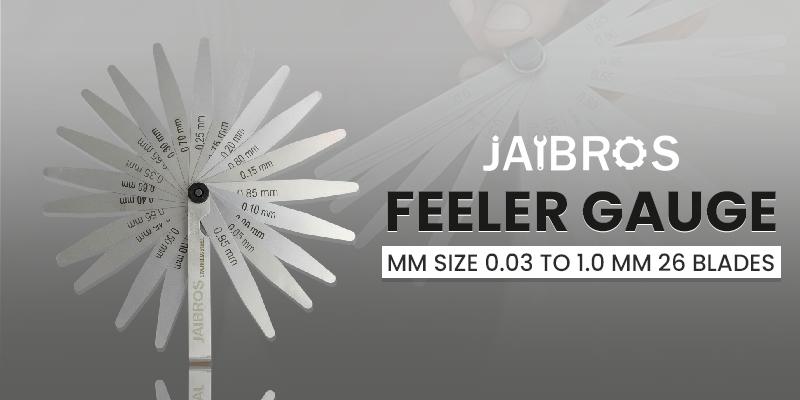Most Common Feeler Gauge Mistakes and How to Avoid Them

learn how a feeler gauge helps measure small gaps in machines and engines. Understand sizes, least count, price and how to choose the right 26-blade set
How a feeler gauge works and what it measures
Each blades' thickness is stamped onto each blade. All of the metric blades range from 0.03mm to 1mm thick, as provided for the Jaibros metric set.
To use the feeler gauge to measure a space/gap, place different thickness blades on top of each other to see which thickness fits nicely in your desired measurement gap. If necessary, aggregate (i.e., stack) the blades to give an even better accuracy of where on the gap mark you want to measure.
Due to its simplistic nature, a feeler gauge can be used with ease to measure tighter areas than a caliper or micrometer can measure due to their bulkiness.
Typical sizes and least count / accuracy
-
Many feeler gauge sets — including those with metric sizes — span a thickness range from about 0.04 mm up to 1.00 mm.
-
Some sets start even lower. The Jaibros 26-blade set starts from 0.03 mm — that gives finer control for very small clearances.
-
Blade lengths in common sets are often around 75 to 127 mm (3 to 5 inches) — enough for normal tasks. Longer blades — up to 300 mm or more — exist for hard-to-reach gaps.
As for accuracy (least count), high-quality blades are ground and calibrated to assure each thickness is correct. Many sets follow calibration or metrology standards to ensure reliability.
Because blade thickness increments are small (for example 0.03 mm, 0.04, 0.05, 0.06… etc.), you can reliably measure gaps with precision up to the smallest blade — which is often enough for engine tuning, bearing clearance, or other mechanical adjustments.
Where and when a feeler gauge is useful
A feeler gauge is not a general-purpose measuring instrument like a caliper or micrometer. It is specialised for measuring gaps or clearances — especially when those gaps are small and need accurate measurement. Some uses:
-
Checking valve clearances in engines. Since valve-tappet clearances are small, and require precise measurement, a feeler gauge is ideal. Measuring bearing clearances, gear lash, or small slot widths in machinery. The thin flexible blades adapt to curved or uneven surfaces.
-
Adjusting spark-plug or distributor gaps (where needed). Often comparable tool sets may also use wire-type gauges, but flat blades still find wide use for many gap measurements.
-
General workshop maintenance, where you need to check alignment, clearance between parts, or verify if a component fits properly.
Because feeler gauges are foldable and compact, they are easy to carry and store — a handy tool in any workshop kit .
Choosing the right feeler gauge set — what to check
When you pick a feeler gauges, keep these points in mind:
-
Thickness range & increment: For fine mechanical work or engine adjustments, a set starting from 0.03 or 0.04 mm is good. A wider range (up to 1.0 mm) covers larger clearances. Sets with small increments (smallest step 0.01 mm or similar) give better precision.
-
Material & finish: Hardened steel or stainless steel blades resist wear and resist rust. For workshop use in India (where humidity or moisture may cause rust), anti-rust treated blades are preferable.
-
Blade length and width: Standard length is fine for easy-to-access gaps. For hard-to-reach or deep spots, longer blades help. Also ensure blade width suits the gap you measure.
-
Clear markings: Thickness should be etched or laser-marked clearly on each blade so identification is easy, even after repeated use.
-
Quality and calibration: Good sets are manufactured to calibration standards, ensuring the marked thickness is accurate within tight tolerance. That ensures reliability when you measure.
How to use a feeler gauge properly
-
Clean the surfaces you want to check — remove dirt, oil or debris.
-
Select a blade of roughly the expected thickness (for example 0.10 mm).
-
Slide it gently into the gap. If it goes in easily with slight drag but without force — that is the correct thickness.
-
If it is too loose, try a thicker blade; if it is too tight or cannot go in, use a thinner blade or stack thinner blades.
-
For more accurate measurement, combine two or more blades — since feeler gauges are flat and stackable. The sum of thicknesses then gives the total clearance.
-
After use, wipe the blades clean, apply light oil (if not already rust-protected), and store the set in a dry place. Proper care ensures long life and consistent accuracy.
Conclusion
A feeler gauge is a simple but very useful tool when you need to measure small gaps or clearances between mechanical surfaces. With its set of thin metal blades, each marked with a precise thickness, you can get accurate measurement by sliding blades into the gap.
For workshop work, engine maintenance or mechanical repair, having a steel feeler gauge set — like the 0.03–1.0 mm 26-blade set from Jaibros — is often enough to cover most clearance-measuring needs. It gives good value, adequate precision, and easy use. If you pick a set with proper increments, clear markings and resistant material, and if you use it carefully — it will serve well for a long time.
If you build machines, repair engines, assemble parts or maintain old equipment — keep a feeler gauge in your toolkit. It helps you check critical clearances and avoid mechanical problems caused by wrong gap settings.
Frequently Asked Questions (FAQ)
-
What is a feeler gauge used for?
It is used to measure the size of small gaps or clearances between machine parts or surfaces. -
What sizes are common in a feeler gauge set (in mm)?
Many sets cover from about 0.03 or 0.04 mm up to 1.0 mm. -
What is the least count or accuracy of a good feeler gauge?
Good sets have blade thickness accuracy to within a few hundredths or thousandths of a millimetre, making them precise for gap measurement. -
Can I use a feeler gauge for engine valve adjustment?
Yes it is ideal for setting clearance between valve and tappet in an engine. -
How should I store a feeler gauge after use?
Wipe it clean, apply light oil if necessary, and store it in a dry place to avoid rust and maintain accuracy.





